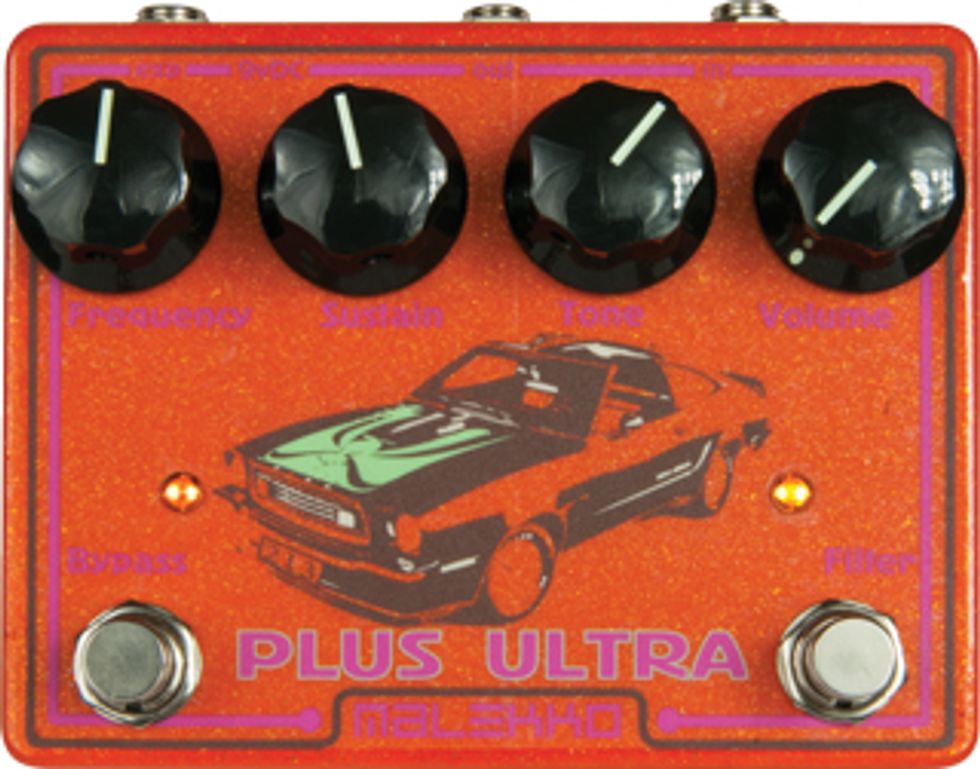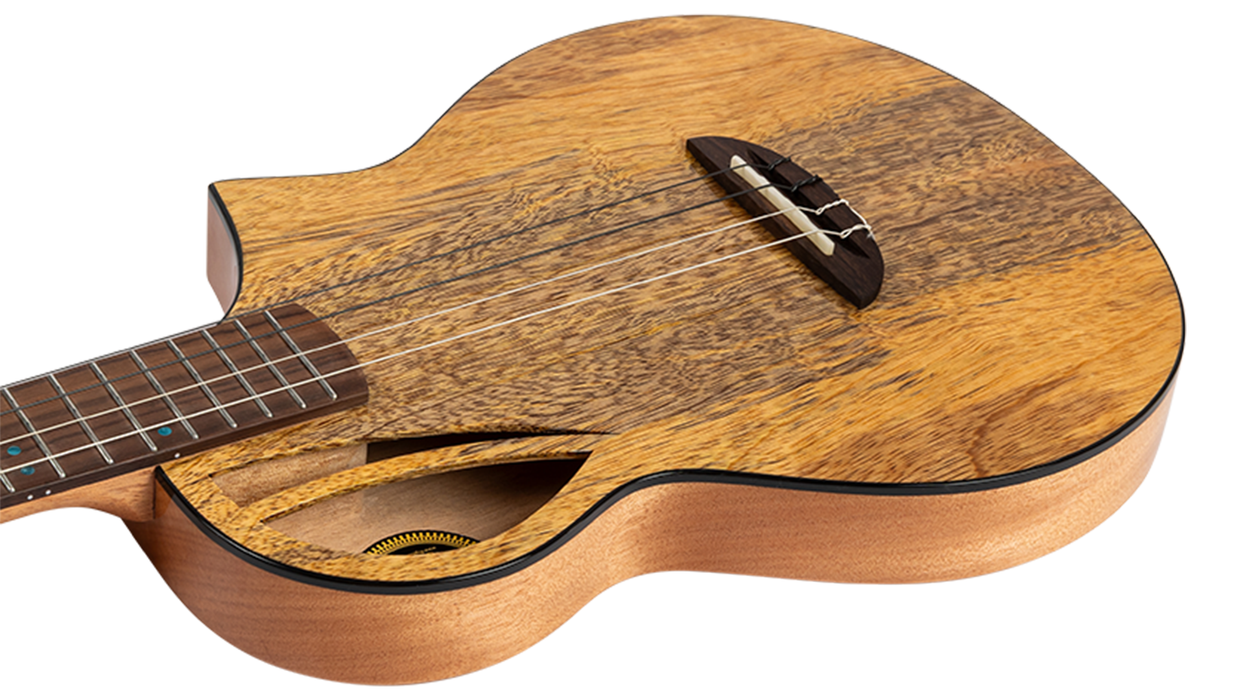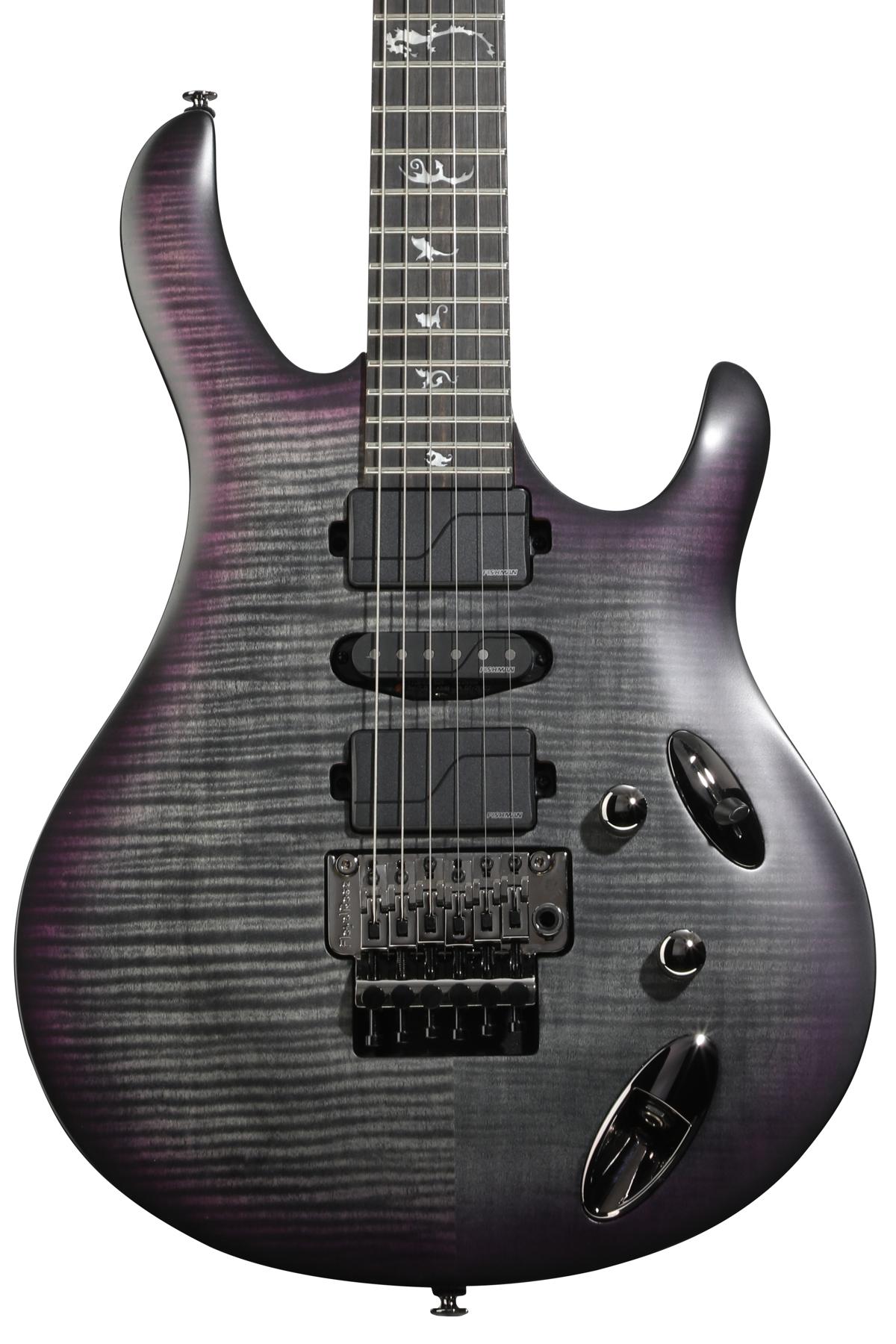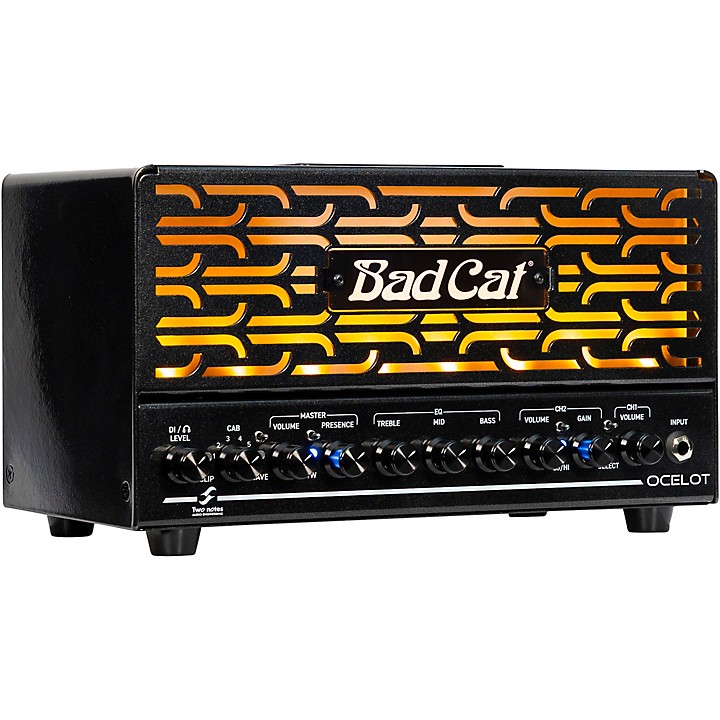
We’ve grown accustomed to stompbox companies big and small using pedal housings themselves as a canvas to differentiate their wares with a little rock ’n’ roll visual craziness. But it would be hard for a pedal to convey its intent through graphics more accurately or effectively than the Malekko Plus Ultra 213. Resplendent in orange metallic flake and a washed-out image of a Mustang Cobra II (Farah Fawcett and Cheryl Ladd’s ride of choice in Charlie’s Angels, natch!)—this pedal screams haze-of-smoke, Sabbathoid, desert-highway-shimmering-with-heat, shag-lined custom-van/muscle-car rock.
What’s cool about the Malekko Plus Ultra 213 is how well it delivers on the promises the fancy graphics make. Like many Malekko boxes we’ve tried, the Plus Ultra 213 is deep with functionality and tones. And what’s doubly awesome about this groovy-looking stomp is how readily and wonderfully it performs outside the most obvious applications—using a combination of an all-pass filter and wide-ranging tone and sustain controls to put burly overdrive and searing hornet-buzz fuzz at your fingertips, as well.
Crushing Orange
Though it’s flashy, to say the least, the Plus
Ultra 213 is a pretty un-fussy and elegant
piece of pedal design. Four knobs line the
top of the pedal, and the three rightmost
controls—sustain, tone, and volume—will
be familiar to anyone who’s ever used a Big
Muff or similar fuzz. The last remaining
knob on the left controls the resonant frequency
of the filter and unlocks the more
mind-expanding tones within. Apart from
the four knobs, there’s a switch for bypass
and one for activating the filter circuit.
Not surprisingly, the addition of the filter circuit makes the Plus Ultra 213 a little busy under the hood, but it’s also very tidy and carefully put together. Perhaps the only complaint you could make about the Malekko’s construction is that the excellent graphics are a decal rather than screen printed, which dulls the sparkle of the metal flake paint and diminishes the air of top-shelf quality that otherwise distinguishes the pedal. On the other hand, if using a decal makes sounds this cool more affordable, it’s most definitely a smart trade.
Mean, Muscular, and Malleable
Were the Plus Ultra 213 a simple fuzz
alone, it would stoke any rocker obsessed
with the sounds of Iommi, Randy
California, Clapton’s Cream–era tones, or
the desert rock and neo-psych of Kyuss,
Fu Manchu, and Tame Impala. At fairly
neutral settings, it’s naturally geared toward
the boxy-but-harmonically-rich and wooly
tones that define a lot of late-’60s and
early-’70s riffery, as well as the work stoner-rock
acolytes. What’s remarkable about the
Plus Ultra 213 in these sonic environments,
however, is how much definition and harmonic
content it retains through the murk.
And players who’ve tossed their Muffs
across the room in frustration over losing
picking nuance and midrange in these furrier
fuzz zones will be thrilled at the extra
grind that the Plus Ultra 213 lays on top of
it’s more corpulent, Muff-like foundation.
But one of the real treats of the Malekko is how easy it is to deviate from the desert-rock template. Cranking the tone control all the way clockwise makes the Plus Ultra 213 sizzle and buzz more like a Maestro FZ-1, Tonebender Mk 1, or Fuzzrite, but with more body—a tone that’s fantastic for rising above a power trio or lending a little mid-’60s biker rock or Stooge-punk attitude. Keep the tone up and roll back the sustain all the way, and the Plus Ultra is a sweet high-gain overdrive that works beautifully with single-coils in particular, and can lend a little extra sass to blues-rock leads or country rock.
As tasty as its fuzz voice is, it’s the all-pass filter that really makes the Malekko special. Once you’ve introduced the filter circuit into the mix, the filter knob shifts the filter’s resonant frequency—emphasizing treblier points on the harmonic spectrum as you move the knob clockwise and creating an effect akin to parking a wah in a given position and adding a subtle phasing effect. Depending on where you set the resonant frequency, the filtered fuzz can also seem a lot more present and louder, which is a real asset if you play in loud band where it’s tough to get a lead out over the mix. The benefit here is twofold—you get a boost in your signal and a sonically arresting, psychedelicized fuzz tone that will stand out and float above the most punishing cacophony.
Ratings
Pros:
Killer range of character-rich fuzz tones. Supreme
desert-rock tone machine. Looks freaking awesome.
Cons:
Expression pedal crucial to accessing full potential.
Tones:
Ease of Use:
Build:
Value:
Street:
$195
Malekko Heavy Industry
malekkoheavyindustry.com
The filter function is most fun and expressive, however, when you add an expression pedal to the mix. Moving the filter through its range with a foot controller emphasizes the all-pass filter’s phasing qualities and opens the door to heavily lysergic mutations of phase, fuzz, and wah sounds that are typically hard to deliver and control this effectively without the help of an analog synth circuit. It’s a function that makes the Plus Ultra 213 a very versatile fuzz weapon capable of delivering genuinely show-stopping and out-of-the-ordinary tones—particularly when you take advantage of the way that it interacts with the tone control.
The Verdict
While the Plus Ultra 213’s strengths and
emphasis are ’70s-style and desert-rock
fuzz tones, it’s the pedal’s range that distinguishes
it from the rest of the heavy fuzz
pack. And given the Malekko’s potential to
move between searing bumble-bee fuzz and
creamier near-overdrive tones, it’s easy to
imagine players across myriad styles making
this a go-to fuzz or abandoning the
two-to-three fuzz strategies that clutter a lot
of pedalboards. Really cracking open the
Malekko’s potential demands the addition
of an expression pedal, and given that it’s
already priced right around 200 clams, the
most complete version of the Plus Ultra 213
experience will cost you if you don’t have
a spare expression pedal around. Still, even
without the sweepable filter capability, the
Malekko can do the work of multiple fuzzes,
which makes the expense considerably
more palatable. And if you’re out for the
ultimate muscle-car-barreling-down-a-barren-
two-lane-road fuzz tone, the Plus Ultra
213’s ability to deliver on the promise of it’s
hot-rod-emblazoned exterior may alone be
worth the price of admission.







![Rig Rundown: Russian Circles’ Mike Sullivan [2025]](https://www.premierguitar.com/media-library/youtube.jpg?id=62303631&width=1245&height=700&quality=70&coordinates=0%2C0%2C0%2C0)

















